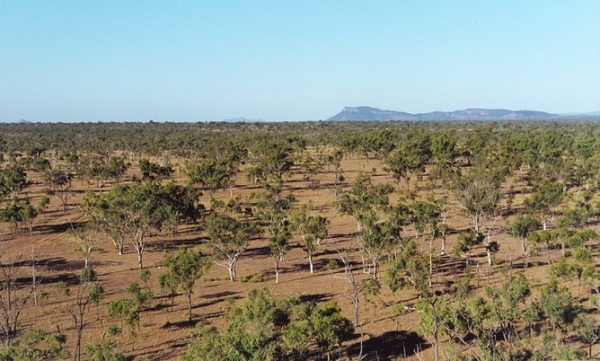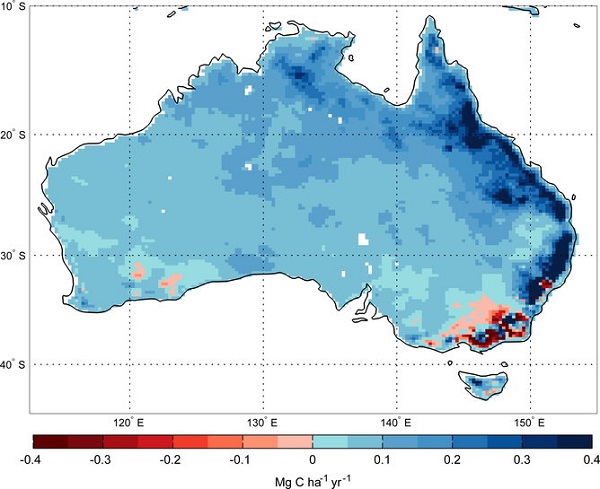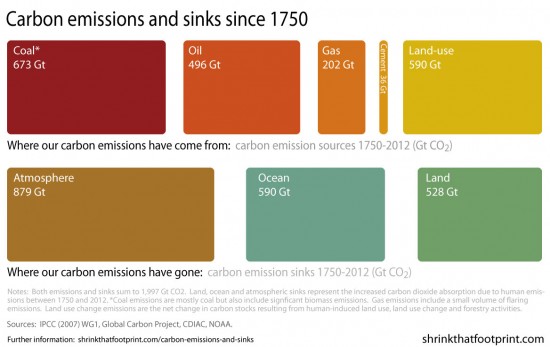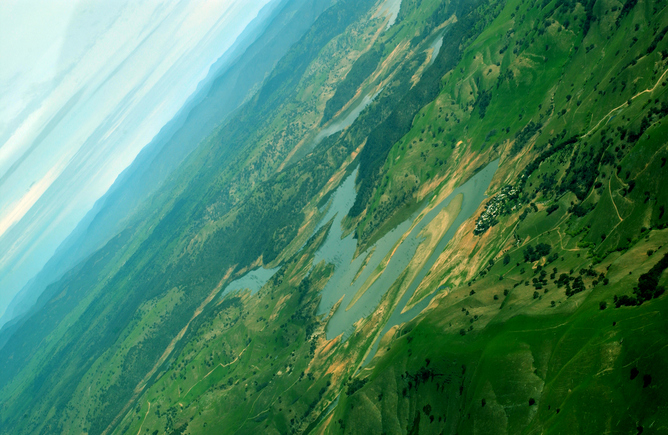New research using satellite technology has found that overall, despite deforestation, the earth is getting greener.
For the period 2003-12, we found that the total amount of vegetation above the ground has increased by about 4 billion tonnes of carbon.
Deforestation in the tropics in South America, Southeast Asia and elsewhere “has been offset by recovering forests outside the tropics, and new growth in the drier savannas and shrublands of Africa and Australia.”
The following image shows light vegetation growing over very large areas. It reminds me of the country we saw last year on our Red Centre holiday, driving in the Northern Territory west of Boulia and north of the Simpson Desert, which would be classified as ‘drier savannah’.

The map they created of Australia (below) shows vigorous growth in the east and northeast in the higher rainfall areas. Some of this would be mountainous forest area, but a good deal of it would be pasture land used for grazing.

Four billion tonnes sounds like a lot of carbon, so we need some perspective. First multiply by 3.67 and that gives an equivalence of about 14.7 billion tonnes of CO2. Back in 2006 in the Stern Review the total world output of humanly generated greenhouse gases from all sources, not just CO2, was from memory 43 Gt of CO2 equivalent. Now that has increased to about 50 Gt CO2e per annum. So I make it that the increased greenhouse gas output over 10 years could be about 35 Gt.
These are very rough calculations, but it makes the extra greenery look quite significant.
Lindsay Wilson has done an historical account of carbon sinks and sources:

That makes 26.4% historically absorbed on land, 29.5% by the ocean and 44% remaining in the atmosphere as the ‘airborne fraction’. Then is not now, but I understand the rough proportions are now 25% absorbed by land, 30% by the ocean and 45% remaining in the atmosphere.
Back in 2009 the airborne fraction was assessed at 43% and found not to change much over the years.
These figures need to be done by real scientists. However my back of the envelope accounting suggests that trees may be more than pulling their weight as a carbon sink. Nevertheless the oceans are still acidifying and atmospheric concentrations are still increasing by about 2.5 ppm each year. So while the news is good there is no reason to crack out the champagne just yet.
There are some other cautions too.
First, I understand shrubs and trees have a lower reflectivity than grasslands. Hence if the trees thicken then more heat will be absorbed by the planet. This is especially true of the tundras.
Second, the Amazon is still a worry. A recent study shows that the carbon absorption capacity has reduced by a third during the last decade, that’s a billion tonnes each year.
About half the rainfall in the Amazon is generated by transpiration. Reducing the tree cover increases the likelihood of drought, which exposes the forest to die-back and fire. I can’t confirm the size of the carbon store of the Amazon, but from memory it’s about 70 billion tonnes, and I think that’s carbon rather than CO2. I did read that there were 5 billion trees in the forest. In any case it’s big and its preservation has global significance.
Third, thickening of forest cover is not all good news for food production. As shrub and tree species, native or otherwise, invade grassland at some point the shrubbery takes over and the grass is lost. Thickening in general can negative for productivity.
Back in 2007 a government report found that the Queensland beef industry was broadly neutral in terms of greenhouse emissions, with methane from ruminants being absorbed by extra tree cover. The present research would tend to support that view.
We live in a complex world.
Update: On reflection, I think the additional greening possibly needs to be measured against the whole land-based carbon sink function. If so then it’s rather lacking.
That’s why we need real climate scientists in this specialty to do the calcs!


On reflection, I think the additional greening possibly needs to be measured against the whole carbon sink function. If so then it’s rather lacking.
That’s why we need real climate scientists in this specialty to do the calcs!